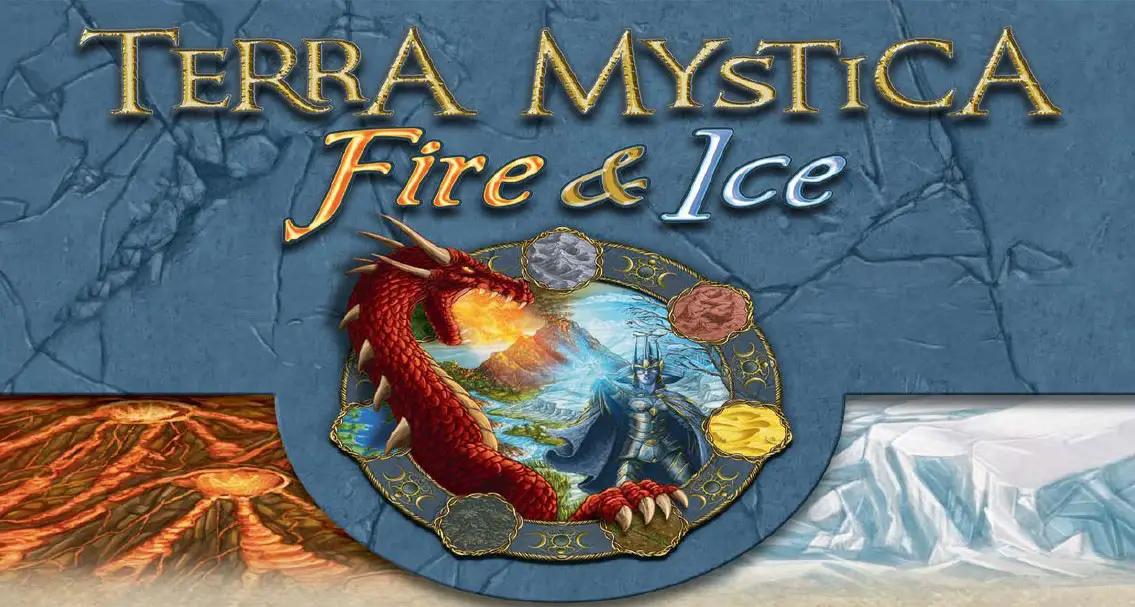
The peoples of Terra Mystica have been witnesses to many great changes throughout the land.
After all, the fact that the landscape all around them is ever-changing is part of their daily life, and more often than not , they are responsible for that change. But the rumble caused by the volcanoes and the glaciers that transform regions into icy plains... That is something new to them.
And while the Council of Elders still debates as to the causes of this sudden climate change, new beings have started to appear, and they too wish to impose their will upon the land...
Terra Mystica Fire & Ice is an expansion for the game Terra Mystica, which is required to play this expansion.
The expansion provides a new game board, 6 new factions and additional game options to add more variety to the game. The new terrain types Ice and Volcano will make you feel either warm or cold all over.
Components
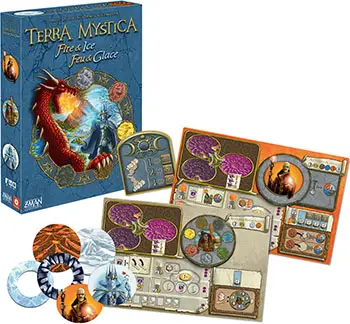
- 1 Game board
- 3 double-sided Faction boards
- 1 Turn Order board
- 16 Dwellings
- 8 Trading houses
- 2 Stronghold
- 6 Temples
- 2 Sanctuary
- 14 Priests
- 14 Markers
- 6 Bridges
- 30 Terrain tiles
- 10 Faction tokens
- 4 Final Scoring tiles
- 1 Cloth bag
- 1 Ice ring 1 Shapeshifter ring
Setup
The setup remains the same as in the base game. Due to some of the new game options, however, it may require additional components to be added.
New Game Board
The new game board can be used instead of the old one, and this time it mentions the conversion of money into Victory points during the final scoring! Of course, you can use all of the new factions and game options with the old game board all the same.
New Terrain Types
Ice Maidens and Yetis settle in Ice; Acolytes and Dragonlords settle on Volcano spaces. When they transform a space, they place the appropriate Terrain rile on it. Ice and Volcanoes cannot ever be transformed into any other type of terrain, neither by using Spades nor via Special Actions.
New Final Scoring
During setup, shuffle the Final Scoring tiles face-down, draw one and place it face-up next to the game board. Tins tile will be scored after the Area scoring at the end of the game.
Each of the following Final Scoring tiles follows the Area scoring rules: only Structures that are within the same cluster of directly or indirectly adjacent Structures count (i.e. connected Structures).
As in the Area scoring, the best player gets 18 Victory points, the second-best gets 12, and the third-best gets 6 Victory Points. As usual, in case of a tie, add up the Victory points for the respective ranks and divide them up evenly (rounding down if necessary).
The Final Scoring tiles in detail
In the following examples, the Fakirs, Mermaids (with a Shipping value of 4), Giants (with a Shipping value of 1) and Witches (with a Shipping value of 2 - thus, their 3 Dwellings on the left are not connected with their other Structures) are playing against each other.
Greatest Distance:
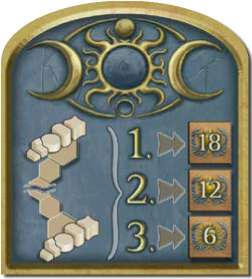
Each player determines the distance between the two of Iris connected Structures that are the farthest apart from each other.
To determine tins number, count the number of spaces between those two Structures (counting the space of one of those two Structures).
If there are multiple paths between them, choose the shortest one of them.
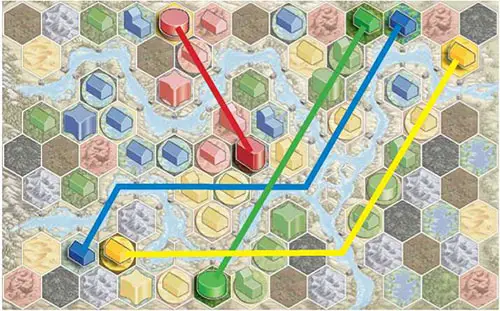
Mermaids and Fakirs both have a greatest distance of 12. Each of them gets 15 Victory points (18+12=30; divided by 2 =15). The Witches' greatest distance is 8, which is the third-best value, so they get 6 Victory points.
Stronghold and Sanctuary:
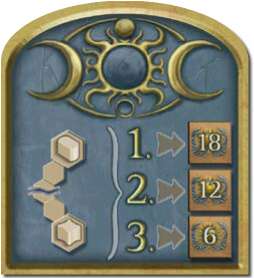
Each player determines the distance between his Stronghold and his Sanctuary (they must be connected).
To determine this number, count the number of spaces between those two Structures (counting the space of one of the two Structures).
If there are multiple paths between them, choose the shortest one of them. (If you did not build both of these Structures, you do not get any Victory points for this Final Scoring tile).
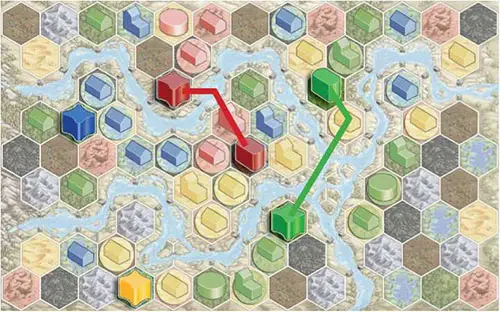
The Witches are best with a distance of 4. The Giants are second with a distance of 3. The Mermaids and Fakir have not built their Sanctuaries, so they do not get any Victory points in this category.
Outposts:
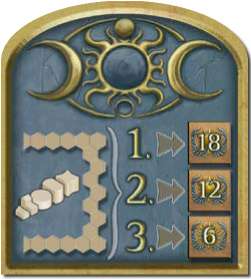
Each player counts die number of Structures he built on border spaces of die map. These Structures must be connected.
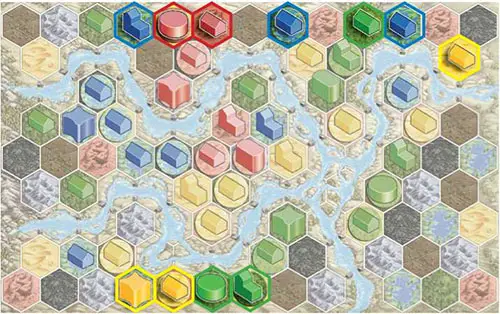
The Mermaids, Fakirs and Witches each have 3 Structures on border spaces of the map (within the same respective cluster). Each of them gets 12 Victory points.
Settlements:
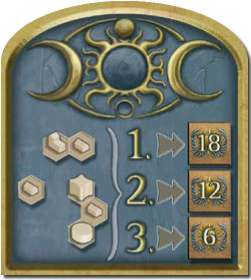
Each player counts the number of his Settlements. A Settlement is a cluster of directly adjacent Structures of one color.
Single Structures that are not directly adjacent to any other Structures of the same color are also considered Settlements. Scored Settlements must be connected as well.
(All Structures in a Mermaid Town crossing a river are considered part of the same Settlement).
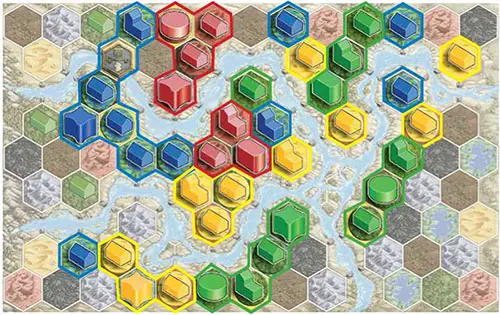
The Fakirs have 7 Settlements, the Mermaids have 6, and the Witches have 4. They get 18,12 and 6 Victory points, respectively.
The New Factions
The Ice Factions
When choosing an Ice Faction, you must also immediately choose a Starting terrain. This will be the terrain on which you will build your first Structures and from which you will later count the Spades on the Transformation cycle when transforming terrain.
The chosen Starting terrain may not be the Home terrain of an already chosen Faction (including the Riverwalkers and Shapeshifters).
Indicate your choice with the Ice ring. Place it over the chosen terrain type on your Transformation cycle. The following players may not choose a Faction with that type of Home terrain. The Ice factions use the white playing pieces.
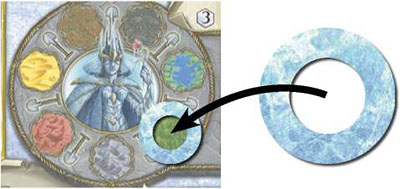
Example: Jeff chooses the Ice Maidens. He cannot choose Wasteland or Swamp as his Starting terrain, because the Giants and the Darklings are already in play.
He chooses Forest and places the Ice ring over Forest on his Transformation cycle. As a consequence, Alice - the fourth player - may not choose the Witches or the Auren as her faction.
When placing your first two Structures, each time place a (free) Ice Tile on the chosen Starting terrain space before placing the Structure.
During the course of the game, when transforming other terrain into Ice, count the number of Spades between the source terrain and your Starting terrain - this is the number of Spades needed to go through with that transformation.
When transforming your Starting terrain into Ice, you pay exactly 1 Spade! As usual, you may transform terrain partially and stop at any other terrain type.
In the example above, the Ice Maidens would require 1 Spade to transform Forests, Mountains and Lakes into Ice, 2 Spades for Wastelands and Swamps, and 3 Spades for Deserts and Plains.
Ice Maidens
Ability:
When choosing the Ice Maidens, also take one Favor tile of your choice. Immediately advance the depicted number of steps in the given Cult and, if appropriate, gain Power by doing so.
If the chosen Favor tile shows income, you will receive that income in Phase I of the first (and any subsequent) round. Any other abilities of that Favor tile can be used in Phase II of the first (and any subsequent) round.
Stronghold:
After building the Stronghold, each round when passing, get 3 Victory points for each of your Temples on the game board.
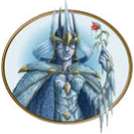
In old tales, it is said that the Ice Maidens were once part of the Mermaid faction. They are equally as friendly and lovely, but only cold and frost can make them happy.
Ice Maidens love gifts - give them something and they will never let it go, especially since most things will freeze to their hands ! This is why you should refrain from shaking an Ice Maiden 's hand despite her seeming to be so friendly.
Yetis
Ability:
Whenever you choose to take one of the Power actions printed on the game board, pay 1 fewer Power.
Your Stronghold and your Sanctuary have a Power value of 4 (which is relevant when gaining Power via other players' building activities and when founding Towns).
Tip: Place a Power token on each of these Structures to remind you of tins.
Stronghold:
After building the Stronghold, from now on, you may use the Power actions printed on the game board even if they have been taken already (by you or another player). If you use a Power action that has not been taken already, cover it with an Action token as usual.

Yetis do not exist. No, not even in Terra Mystica. However, there are rumors about recluses who are done with civilization , living on glaciers and ice floes and who have not shaved for ages.
They are said to be skillful artists who sell their ice sculptures to other people while scaring them by telling horror stories about an imminent ice age.
Later, when the ice sculpture melts above the chimney , its buyer will become unsure of whether the encounter with the Yeti was real or just a dream.
The Volcano Factions
Choose a Starting terrain after each other player has chosen a Faction. You may not choose the Home or Starting terrain of another Faction in play (including Ice Maidens, Yetis, Shapeshifters and Riverwalkers). The Volcano Factions use the orange playing pieces.
When placing your first two Structures, each time place a (free) Volcano tile on the chosen Starting terrain space before placing the Structure.
After that, the Starting terrain for tins Faction no longer has any special meaning. The Volcano Factions never get any Victory points for placing Volcano tiles on the board (since they do not use spades to transform the terrain).
Dragonlords
Ability:
You must use Power tokens to transform terrain. {Power tokens used for Terraforming are removed from your Faction board). Remove 2 Power tokens to transform the Home terrain of another player into Volcano.
Every other terrain type costs 1 Power token. {Ice Maidens, Yetis and Riverwalkers do not have a Home terrain. Ice cannot be transformed). All the required Power tokens must be removed from any one or more of your Bowls.
You cannot use Spades to transform terrain, regardless of whether you gained the Spades via an Action or a Cult Bonus.
Instead, place 1 Power token from the general supply in Bowl I of your Faction board for each Spade you get. {This way, it is possible to have more than 12 Power tokens in your Bowls. If a Scoring tile awards Victory points for using Spades, you get those Victory points).
Stronghold:
After building the Stronghold, immediately and only once place a number of Power tokens from the general supply in Bowl I of your Faction board equal to the number of players. {This way, it is possible to have more than 12 Power tokens in your Bowls).
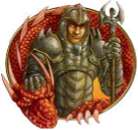
There are a lot of rumors about the relationship between the Dragonlords and dragons. Some say they have a sense for soon-to-be-erupting volcanoes.
A Dragonlord could ride his dragon to the right spot over a volcano and the dragon would then induce an eruption through meditation and spitting fire. (Spitting fire is quite meditative for a dragon).
Both the Dragonlords and dragons benefit from this kind of collaboration - the dragon gets a fresh volcano to bathe in or have a barbeque, and the Dragonlord can use its power for his own purposes.
Acolytes
During faction setup, Acolytes do not receive power for their starting positions in the cults.
Ability:
You must use Cult points to transform terrain. It costs 4 Cult points to transform the Home terrain of another player into Volcano. Every other terrain type costs 3 Cult points each. (Ice Maidens, Yetis and Riverwalkers do not have a Home terrain. Ice cannot be transformed).
To pay the 3 or 4 Cult points, move your Marker down by that many spaces on a single Cult track. (You cannot lose Power by moving down on a Cult track, but you can gain it over and over again when moving up).
You cannot use Spades to transform terrain, regardless of whether you gained the Spades via an Action or a Cult Bonus. Instead, for each Spade that you get, advance 1 step on a Cult track of your choice.
(If you gain multiple Spades, you may choose different Cult tracks for each of them. If a Scoring tile awards Victory points for using Spades, you get those Victory points).
Stronghold:
After building the Stronghold, from now on, advance 1 more step for each Priest that you send to the order of a Cult, i.e. advance by 4/3/2 steps instead of 3/2/1.
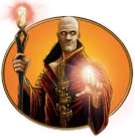
Technically, Acolytes are heretics - according to the other factions anyway. They do not content themselves with worshipping the elements in cults.
Acolytes rather use the power of the elements to cause volcanoes to erupt.
You might notice a little sparkle in their eyes when they watch the hot magma pouring out of an erupting volcano. Some say this is obsession, but it might just be the joy of being able to change the landscape without a single cut of the spade.
The Variable Factions
Shapeshifters
When choosing the Shapeshifters, you must also immediately choose a Home terrain. You may not choose the Home or Starting terrain of another Faction already in play (including Ice Maidens and Yetis). Indicate your choice with the Shapeshifter ring.
Place it over the chosen terrain type on your Transformation cycle. Use the appropriate playing pieces according to your chosen Home terrain. The following players may not choose a Faction with that type of Home terrain.
During the course of the game, count the number of Spades needed to transform terrain based on your chosen Home terrain.
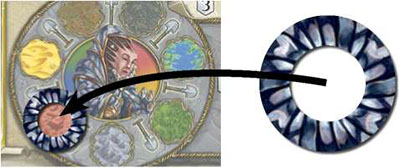
Example: Adele chooses the Shapeshifters. As the Witches are already in play, she cannot choose Forest as her Home terrain. She chooses Wasteland instead and places the Shapeshifter ring on her Transformation cycle appropriately.
As long as Wasteland is her Home terrain, she needs 1 Spade to transform Mountains and Desert into it, 2 Spades to transform Forest and Plains, and 3 Spades for Swamp and Lakes.
Ability:
Whenever at least one of your neighbors takes Power due to your building activity, you may immediately pay 1 Victory point to take 1 Power token from the general supply and place it in Bowl III.
(You will get at most 1 Power token per building activity, regardless of how many of your neighbors take Power. It is possible to have more than 12 Power tokens in your Bowls).
If all of your neighbors refuse to take Power, gain 1 Power instead (i.e. move 1 Power token as per the normal rules). (Like the Cultists, without neighbors, you get neither of those things).
Stronghold:
By building the Stronghold, you gain the ability to change your Home terrain into any other terrain type that is not the Home terrain of another f action in play. (Ice Maidens, Yetis, Acolytes and Dragonlords do not have a Home terrain).
Changing your Home terrain costs 5 Power that you can either pay by moving 5 Power tokens from Bowl III to Bowl I or by removing 5 Power tokens from your Faction board {from any Bowls you like).
This is considered an Action that you can carry out multiple times per round (on separate turns). Indicate your new Home terrain by moving the Shapeshifter ring to the appropriate terrain type on your Transformation cycle. Keep the playing pieces you are playing with.
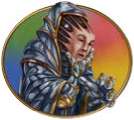
At first glance, Shapeshifters are very friendly and charming creatures. They want to be like you, look like you, live like you and even do what you do.
You might be flattered at first, but soon it will start to get annoying and even become frightening.
Because if you let them, they will gain power through you ...
Riverwalkers
When choosing the Riverwalkers, you must also immediately choose a Starting terrain. You may not choose the Home or Starting terrain of another Faction already in play (including the Ice Maidens and Yetis).
Use the appropriate playing pieces according to the chosen terrain type. The following players may not choose a Faction with that type of Home terrain. Place 1 Priest on each space of your Terrain cycle except your Starting terrain. (Other Factions call it Transformation cycle, the Riverwalkers call it Terrain cycle).
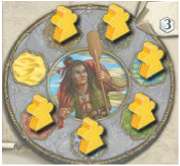
Example: Alice chooses the Riverwalkers and would like to start the game on Desert.
So she places 1 yellow Priest on each of the 6 other Terrain spaces on her Terrain cycle {i.e. Plains, Swamps, Lakes, Forests, Mountains and Wastelands).
Your lirst two Structures (as well as any subsequent ones) must be placed on spaces that are adjacent to the River. From then on, any subsequent Structures must be built within reach of your other Structures according to your Shipping value (which may be boosted by the "Shipping +1" Bonus card).
Ability:
As a Riverwalker, you do not transform terrain but rather unlock more types of terrain you can settle in: every time you gain a Priest, you can - instead of taking him from your supply - remove a Priest from one of the spaces of your Terrain cycle, return him to your supply, and spend additional coins.
It costs 2 coins to unlock a terrain type that is already the Home terrain of another player. Every other terrain type costs 1 coins.
From now on, you can also settle in the newly unlocked terrain. You can use your ability whenever you gain a Priest, regardless of how you gained him.
Stronghold:
After building the Stronghold, you may immediately, and only once, build up to two Bridges for free.
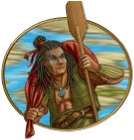
Riverwalkers are beach dwellers - they need the proximity to flowing water to be happy. Long ago, their priests have discovered that it does not really matter what terrain you are living in - an unheard -of discovery for Terra Mystica.
Other than that, they are pretty harmless . Cooking some fresh flash in a fireplace and listening to the music of a distant lute is all that a Riverwalker really needs in life
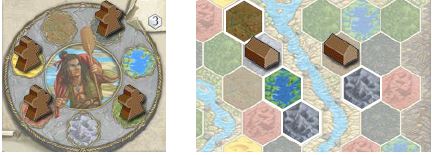
Example: The Riverwalkers {playing brown) have received 2 Priests so far. They used them to unlock Lakes and Mountains on their Terrain cycle. In the situation to the left, they can now build on any of the marked spaces using their Shipping value of 1.
When founding Towns and during the final scoring, Structures that are not connected via Shipping, but directly adjacent, are still considered connected.
Riverwalkers do not know what Spades are - they cannot use them.
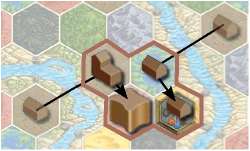
Example: The arrows show you how this Town can be founded. The leftmost Dwelling allows the construction of the Stronghold and Trading house; the rightmost Dwelling, the construction of the two Dwellings in the Town.
The New Game Options
The following game options can be used on their own or in combination with each other.
Variable Turn Order
During setup, place the Turn Order board next to the game board. Beginning with the Starting player and in clockwise order, each player places his Faction token on the topmost free space on the left side of the Turn Order board.
During the course of the game, when passing, move your Faction token to the topmost free space on the other side of the Turn Order board. The Roman Numerals in the middle of the Turn Order board indicate the play order during the respective rounds.
Example:
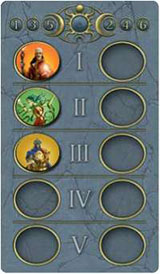
Adele is the Starting player and is playing the Acolytes.
The next player in clockwise order is Alice playing the Auren and then Jeff playing the Nomads.
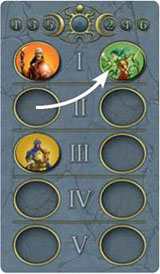
The Auren are the first to pass during the first round and will be Starting player in the next one.
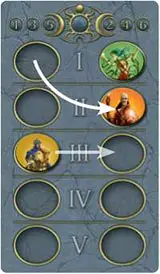
The Acolytes are the second to pass during the first round and, consequently, will be second in play order during the second round.
The Nomads remain last in play order.
Factions for Auction
Setup the game as usual (including the Turn Order board) but do not choose your factions yet. Put all of the Faction tokens in the cloth bag and shuffle them. Then draw from the bag a number of Faction tokens equal to the number of players.
Place the drawn tiles next to the game board. These tiles indicate the factions that will be in play and which are now up for auction. For each of these factions, place a Marker on space 40 of the Victory point track. The players will use these Victory points as currency during the auction.
Randomly determine the player who has to place the first bid (which may be 0). Then each other player in clockwise order may place a higher bid or pass.
The players continue to place bids in this fashion until all but one player have passed. (No player may bid more than 40). The highest bidder chooses a Faction token and places it on a free space on the left side of the Turn Order board. (Only the spaces up to the number of players are available).
Afterwards, he takes the appropriate Faction board and moves his faction's Marker on the Victory point track back a number of spaces equal to his bid. He cannot participate in any of the remaining auctions.
Beginning with the next player in clockwise order (the one to the left of the auction winner), the remaining players repeat this procedure until each player has a faction.
Details
-
After the auction is finished, the initial play order is set. The players build their first Structures, choose their first Bonus cards and play the first round according to this order.
Afterwards, they can decide to play according to the basic rules in clockwise order or continue using the Turn Order board to determine the play order for each subsequent round (see Variable Turn Order).
(They may need to change their seating positions if they choose to play in clockwise order).
-
Factions that may choose their Starting terrain type (Ice Maidens, Yetis, Riverwalkers and Shapeshifters) may not choose the Home terrain of another faction that participated in the auction.
Continue Reading

